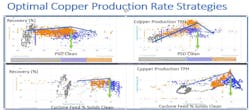Rising global materials and manufacturing demand is fueling urgency in the mining and minerals sector to adapt and innovate faster than ever before. Accelerated especially by the energy transition, this surge is spurring a substantial increase in copper output, a vital mineral for batteries, electric vehicle components and power infrastructure.
Furthermore, as mining companies push toward their net-zero commitments, they must overcome several obstacles, including water scarcity, supply chain disruptions and rising energy costs. All these factors and more are forcing companies to assess their operations, ushering in a new era of mining efficiency.
Shifting mining mentalities
This transformative era is driven by a series of current and emerging digital trends, including the prominent industrial internet of things (IIoT), automation of sectors beyond mineral processing and the adoption of cloud solutions for data storage and sharing. These digital trends provided a sudden and significant increase in the amount, complexity and accessibility of operational and equipment data, which is necessary for innovation.
Leveraging operational data for improved decision-making is not a new practice for miners. The growth of integrated remote operating centers (IROCs) — which make data from multiple sites centrally available — is a great illustration of this, amplifying best practices and efficiencies throughout entire enterprises. While data-driven operations have yet to reach universal adoption in the sector, the mining industry is quickly moving in this direction.
Considering today’s challenging global landscape with supply chain complications, natural resource concerns, skyrocketing mineral demand and the borderless urgency of slowing climate change, the rapid consumption and operationalization of this data has never been more critical.
Advanced analytics fuel the data revolution
Mining and metals companies of all sizes were pinned against the wall of data inefficiencies, but state-of-the-art advanced analytics software solutions are propelling the transformative shift toward improved operational efficiency. These solutions are optimized to connect disparate data sources, provide contextual operational understanding and quickly transform data insights into real-world benefits.
These solutions provide process experts in mining organizations with several benefits:
- Increased operational understanding: From ore mining to refining, these solutions accelerate time to insight for process experts, enabling them to rapidly assess the profitability of various activities. The combined metrics of different equipment pieces provide a holistic view of mine capacity.
- Low risk curiosity: Empowering subject matter experts (SMEs) to explore "what-if" scenarios is pivotal. Despite time constraints, analyzing data can be a game-changer, allowing SMEs to reproduce optimal scenarios or pinpoint issues.
- Accelerated data integration: Digital initiatives are driven by rapid data consumption and solution implementation. Yet, information silos remain a significant barrier, highlighting the need for unified information sources and collaboration. Connecting machine learning back to the SMEs and vice versa can provide success with SMEs at the center of innovation, as exemplified in the Caserones Mine case study later in this article.
To make transformative and lasting impact, advanced analytics solutions must place comprehensive and user-friendly functionalities in SMEs’ hands, such as diverse data source connectivity, operational data cleansing, enterprise-wide collaboration tools and seamless integration into vital software systems — such as maintenance, lifecycle management and business planning systems. Effective data analysis must inform decisive action to move the industry forward.
Deploying advanced analytics solutions in the mining sector
The successful deployment of digital solutions largely depends on organizations’ operational data utilization maturity. Typically, this evolution starts with descriptive analytics — which detail current happenings — and evolves to prescriptive analytics, which suggest methods for achieving desired outcomes.
1 Descriptive analytics: the beginning
Real-time dashboards display operational data, such as pressure and flows, at mineral processing plants and IROCs. Typically, this data is transformed into operational signals that indicate the efficiency of a plant’s operations. Although the analytics involved in these scenarios are often basic, the clear data visualization provided within digital solutions is critical for all audiences engaged.
2 Diagnostic analytics: enhancing quality and reducing variability
To understand the reasons for operational events, diagnostic analytics must include significant statistical analysis to help process experts identify the root causes of problems and pinpoint ideal conditions to reduce process variability. Using standardized data approaches, SMEs can focus on solving more pressing issues, aligning their efforts to meet production and sustainability targets.
Diagnostic analytics encompass practices such as statistical process control (SPC), statistical quality control (SQC) and process capability/performance indicators, which can be challenging to automate when considering the variable limits across different operational modes. By leveraging an advanced analytics solution such as Seeq, SMEs can simplify these procedures, enabling dynamic creation of charts and easing the task of frequent analysis.
3 Predictive and prescriptive analytics: leveraging data to optimize operations
First principles modeling, while cost-effective, can be limiting when dealing with complex equations. In these cases, complex multivariate analyses — for example, predicting mineral recovery from grinding inputs — come into play. With predictive models, SMEs can make immediate process adjustments, reducing mineral loss. Operating ranges can also be optimized to maximize yield and decrease energy consumption.
Using prediction tools within advanced analytics solutions, SMEs can model crucial parameters to provide foresight into the recovery process. However, these tools are limited by model quality and hampered by inaccurate assumptions, so pairing solutions with machine learning (ML) can help avoid errors.
ML models thrive on training with high-quality historical data to anticipate events. For instance, SMEs frequently use the technology to forecast equipment malfunctions before they impact operations.
Data quality is also a key factor when it comes to the efficacy of a model. Combining ML with Seeq helps seamlessly connect to live data sources, refine available data and ensure the results are actionable for relevant personnel, including process engineers, operators, data scientists and more.
Case study: Caserones Mine
Caserones is an open pit copper mine in Chile that produces 110-150 fine metric tons per annum (KTMF/y) of copper concentrate, 30 KTMF/y of copper cathode and 3 KTMF/y of molybdenum. It has been in production for 10 years and, like many other mines, it struggles with lower ore grades and water scarcity.
Freddy Retamal, Energy and Automation & Technology Manager at the Caserones Mine, distinguishes the facility’s digital transformation strategy as combining leadership and technology to achieve success. The critical pieces of the digital infrastructure are energy availability and telecommunications, the interaction of information technology (IT) and operational technology (OT) solutions, the scale-up of digital twins, the implementation of ML-based advanced analytics and an IOC.1
To make production improvements, the mine sought to consolidate operational data silos, build a digital twin, use dynamic process models to determine optimal mill throughput and create a continuous improvement cycle. The resulting data is used for process monitoring, situational awareness and asset reliability, providing the starting point for advanced analytics (Figure 1).
The team set out to determine optimal mill throughput using advanced analytics, considering particle size (P80), % solids in the cyclone feed rate (% solids) and metal recovery estimates in the flotation banks. They began by building a baseline of energy and water consumption, plus production rates during various operating modes — i.e., start-up, idle, normal operation, maintenance, etc.
The team selected Seeq, an advanced analytics solution, to aggregate inputs and production losses. Additionally, and more importantly, this solution provided the ability to filter all operational data for each business unit to create predictive models based on units running under acceptable parameters. These models were then used to estimate values for critical variables involved in process control and stabilization (Figure 2).
The advanced analytics solution also provided the techniques to confirm the correlation of critical variables, such as the ones shown in Figure 3. The metal recovery and production rate plotted against P80 and % solids show a decrease in yield when the % solids are above a constraint of 67%-68%, which is specific for the ore grade of the mine. It also strongly correlates with the P80 of 200-210 microns as an overall indicator of grinding product quality.
This approach — aided by dynamic models for hydro cyclones, SAG-SUMP-cyclones, flotation banks and thickeners — has led to a metal recovery rate increase of more than 4% and additional water recovery of 1,500 tons per hour.
Sustainably meeting market needs
Increasing production demands coupled with the need to meet global sustainability initiatives have catapulted digital transformation with advanced analytics solutions toward the top of mining companies’ priority stacks. Adoption of modern digital tools is critical for continued success.
Equipped with these means, miners can centralize disparate data, increase production yield, reduce waste, improve process efficiency and easily communicate results throughout entire enterprises, helping companies collectively achieve their objectives and meet market mineral demand.
References
[1] Retamal, Freddy. “Automation And Technology Roadmap In A Very Low-Grade Mine, Severe Climate And In High Mountain.” Process Optimization through Innovation, Technology, Automation, and Design. Copper 2022. Nov. 2022. Santiago, Chile.
Mariana Sandin has more than 15 years of experience in enterprise industrial software and analytics, and she leads the mining, metals and materials practice at Seeq.
Seeq





